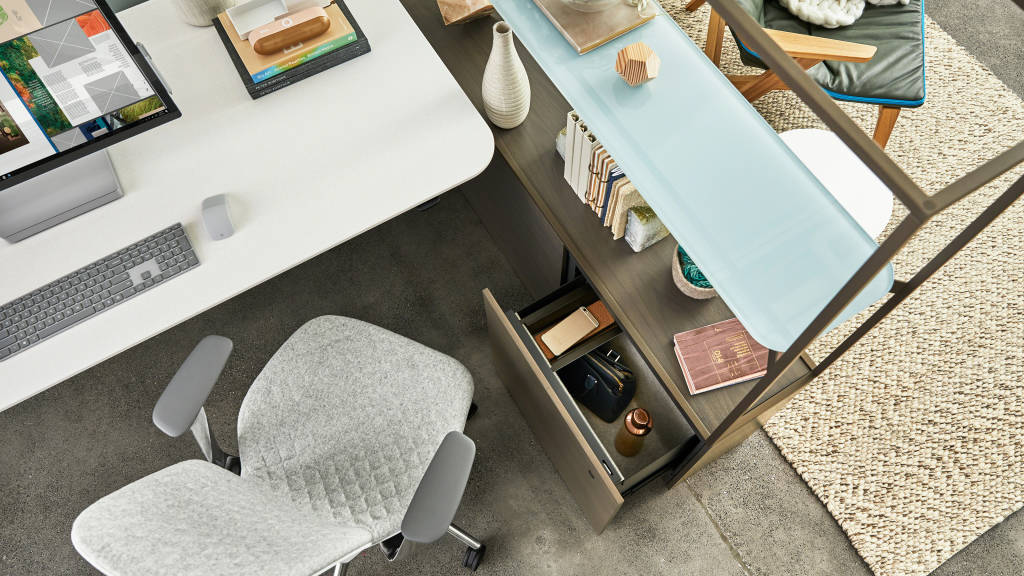The cantilever worksurface design eliminates barriers and allows people to easily shift from individual, focused work to collaboration.
The sun isn’t up yet, but you are. You’ve learned that early morning is your best chance for personal time—before the calls start coming in, before your mind gets stretched in multiple directions, before the demands for your attention intensify. Once in the office, your day will most likely begin with a series of meetings with little or no time in between to prepare or even think about the next one. You grab lunch on the go and try to switch gears as you hurry to your next destination. Often, it feels like your brain can’t keep up with your body as you move between tasks and locations throughout the day. Your desk, if you have one, has become a mere landing spot where you try to focus on something or just catch your breath for what’s next. Staying on top of a swirl of priorities everyday is crucial for getting results in your job. And it’s definitely become a lot harder.
Stanford professor Jeffrey Pfeffer writes in his book “Dying for a Paycheck” that workplace stress is taking a physical and psychological toll on employees and costing employers billions. Nearly 50 percent of workers report that they’ve missed time at work because of job-related stress and 61 percent say they’ve become physically ill, according to his research. Pfeffer argues that the situation is getting worse and having an impact on engagement, turnover and job performance.
UNDERSTANDING THE PANDEMIC OF HIGH-STRESS WORK
Steelcase researchers Patricia Kammer and Julie Barnhart-Hoffman know that employees in leadership roles contend with tremendous stress in their high-intensity jobs. As they observed the frenetic pace of leaders’ workdays, they saw that it extracted a high toll on their energy and wellbeing — physical, mental and emotional. In detail, the researchers documented several stressors that many leaders experience nearly every minute of every day:
They need to constantly switch informational and decision-making contexts, continuously toggling their brains between macro and micro perspectives.
They’re required to manage and consume large amounts of information, masterfully filtering the relevance of multiple streams of content.
They have a high need for access to privacy, mandating easy shifts from high visibility to protected, shielded environments.
Their schedules can be highly fragmented, spanning topics and time zones, making it more difficult to process information and get into the flow of the moment quickly.
They’re more mobile than ever before, getting away from the seclusion of their private offices to enable better information flows.
They need to manage incredibly high levels of stress.Successfully meeting high performance expectations mandates balancing intense work with intervals of personal rejuvenation.
A shelving tower provides people with much-needed visual separation to minimize distractions and allows for moments of respite. It can also host large-scale technology or be used to display personal items.
And it’s not just leaders: The researchers quickly realized that everyone is experiencing greater intensity in their jobs, though perhaps to different degrees or in different aspects of their work. As competition speeds up, work is becoming less predictable and the demands for more creative solutions have increased. We’re all dealing with huge amounts of information every day. We’re all spending more time connecting, collaborating and learning with others, but we also desperately need some time alone. Our schedules are as fragmented as a kaleidoscope and we’re more mobile than ever but, regardless, we all need to quickly reset our minds to each new moment.
“Unfortunately, too often, offices aren’t helping people cope with how much work has changed,” explains Kammer. “Organizations are not providing employees with the types of spaces they need to manage the demands and intensity of work, and this is having a negative impact on their wellbeing. People need access to a range of settings that support different needs throughout the day — collaboration spaces, quiet corners for private conversations, private places where we can really zone in and focus, places where we can find our inner Zen. But even when all these spaces are available, proximity is an important factor. If we lose too much precious time getting there, the pace of our work slows—even though its urgency seemingly never does.”
So Kammer and Barnhart-Hoffman put their heads together with the Steelcase design studio. They asked themselves: How might the workplace be designed to nurture wellbeing and help people thrive as their work intensifies? Could they create a closely connected neighborhood with a range of options so people could quickly shift from different kinds of work — focused individual tasks, collaboration in small groups, learning from each other, socializing — creating a sense of community, just like a well-designed residential neighborhood?



